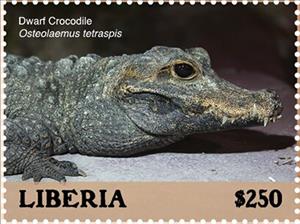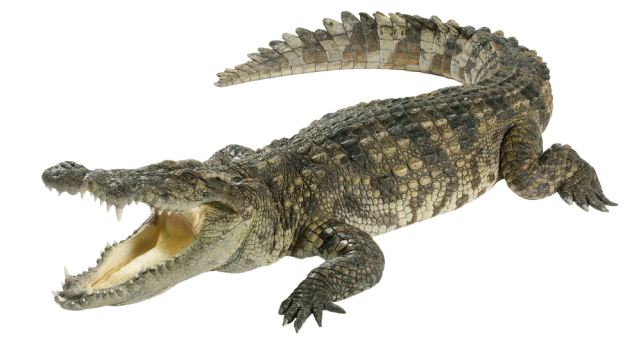Stamp: Dwarf Crocodile (Osteolaemus tetraspis) (Liberia 2019)
Dwarf Crocodile (Osteolaemus tetraspis) (Liberia 2019)
24 April (Liberia ) within release Reptiles of Africa (2019) goes into circulation Stamp Dwarf Crocodile (Osteolaemus tetraspis) face value 250 Liberian dollar
| Stamp Dwarf Crocodile (Osteolaemus tetraspis) in catalogues | |
|---|---|
| Michel: | Mi: LR 7448 |
| Yvert et Tellier: | Yt: LR 6171 |
Stamp is square format.
Also in the issue Reptiles of Africa (2019):
- Stamp - African Rock Python (Python sebae) face value 300;
- Stamp - African Spurred Tortoise (Centrochelys sulcata) face value 200;
- Stamp - Dwarf Crocodile (Osteolaemus tetraspis) face value 250;
- Stamp - Namaqua Chameleon (Chamaeleo namaquesis) face value 350;
- Stamp - Nile Monitor (Varanus niloticus) face value 150;
Stamp Dwarf Crocodile (Osteolaemus tetraspis) it reflects the thematic directions:
Animals are multicellular, eukaryotic organisms of the kingdom Animalia (also called Metazoa). All animals are motile, meaning they can move spontaneously and independently, at some point in their lives. Their body plan eventually becomes fixed as they develop, although some undergo a process of metamorphosis later on in their lives. All animals are heterotrophs: they must ingest other organisms or their products for sustenance.
Crocodiles (family Crocodylidae) or true crocodiles are large semiaquatic reptiles that live throughout the tropics in Africa, Asia, the Americas and Australia. The term crocodile is sometimes used even more loosely to include all extant members of the order Crocodilia, which includes the alligators and caimans (family Alligatoridae), the gharial and false gharial (family Gavialidae) among other extinct taxa.
Reptiles are tetrapod (four-limbed vertebrate) animals in the class Reptilia, comprising today's turtles, crocodilians, snakes, amphisbaenians, lizards, tuatara, and their extinct relatives. The study of these traditional reptile orders, historically combined with that of modern amphibians, is called herpetology. Because some reptiles are more closely related to birds than they are to other reptiles (e.g., crocodiles are more closely related to birds than they are to lizards), the traditional groups of "reptiles" listed above do not together constitute a monophyletic grouping (or clade). For this reason, many modern scientists prefer to consider the birds part of Reptilia as well, thereby making Reptilia a monophyletic class.



